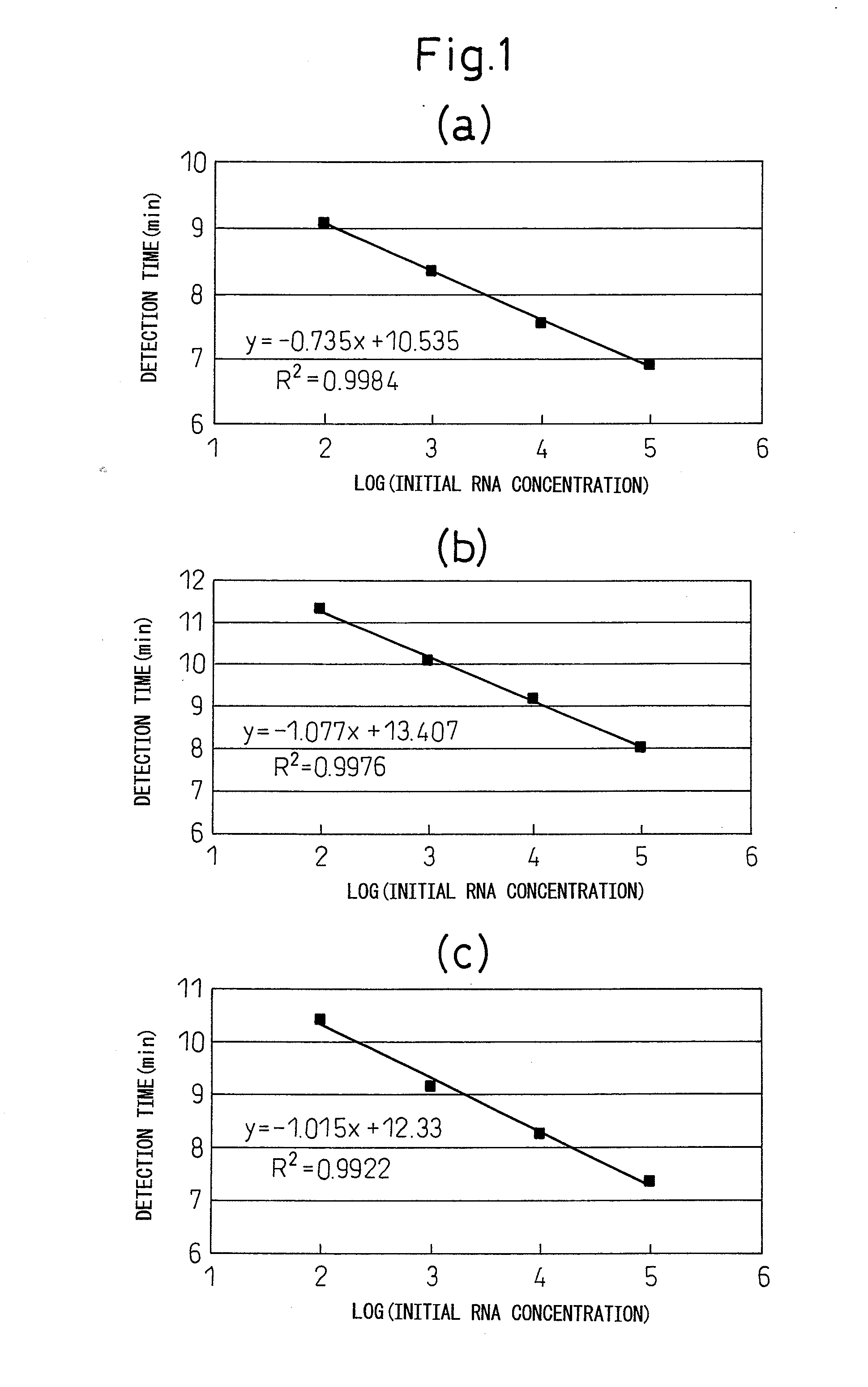METHOD OF MEASURING CYTOKERATIN 19 mRNA
a cytokeratin and cytokeratin technology, applied in the field of cytokeratin 19 mrna measurement, can solve the problems of difficult to distinguish between cancer cells, inability to detect cancer cells, and complexity of the procedure, and the risk of secondary infection
- Summary
- Abstract
- Description
- Claims
- Application Information
AI Technical Summary
Benefits of technology
Problems solved by technology
Method used
Image
Examples
example 1
Preparation of Reference RNA
[0110]CK19 RNA used in the following examples (to be referred to as standard RNA) was prepared using the methods indicated (1) to (2) below.
[0111](1) Double-stranded DNA was cloned consisting of nucleotides from positions 160 to 1353 (1194 bases) of a CK19 base sequence registered with GenBank (GenBank Accession No. NM—002276, 1490 bases).
[0112](2) In vitro transcription was carried out using the double-stranded DNA prepared in (1) as a template. Continuing, RNA was prepared after completely digesting the double-stranded DNA by treating with DNase I and purifying. The RNA was quantified by measuring absorbance at 260 nm.
example 2
Preparation of Intercalating Fluorescent Dye-Labeled Oligonucleotide Probe
[0113]An oligonucleotide probe was prepared that was labeled with an intercalating fluorescent dye. Amino groups were introduced using Label-ON Reagents (Clontech) at the location of the 9th T from the 5′-end of the sequence listed as SEQ ID NO: 39, the 12th T from the 5′-end of the sequence listed as SEQ ID NO: 40, the 13th A from the 5′-end of the sequence described in SEQ ID NO: 41, the 13th C from the 5′-end of the sequence listed as SEQ ID NO: 42, the 7th T from the 5′-end of the sequence listed as SEQ ID NO: 43, the 11th G from the 5′-end of the sequence listed as SEQ ID NO: 44, the 10th C from the 5′-end of the sequence listed as SEQ ID NO: 45, and the 9th G from the 5′-end of the sequence listed as SEQ ID NO: 46, followed by further modifying the 3′-end with biotin. Oxazole yellow serving as intercalating fluorescent dye was labeled to the amino groups to prepare oxazole yellow-labeled oligonucleotide ...
example 3
Measurement of CK19 RNA (Part 1)
[0114]Standard RNA was measured according to the method indicated in (1) to (4) using the cleaving oligonucleotides, first primers, second primers and intercalating fluorescent dye-labeled oligonucleotide probes (to be referred to as “INAF probes”) indicated in the combinations of [1] to [28] shown in Table 1. Furthermore, in Table 1, SEQ ID NO: 19 to 22 constitute partial sequences of SEQ ID NO: 1, SEQ ID NO: 23 and 24 constitute partial sequences of SEQ ID NO: 2, SEQ ID NO: 25 and 26 constitute partial sequences of SEQ ID NO: 3, SEQ ID NO: 27 and 28 constitute partial sequences of SEQ ID NO: 4, SEQ ID NO: 29 to 32 constitute partial sequences of SEQ ID NO: 5, SEQ ID NO: 33 and 34 constitute partial sequences of SEQ ID NO: 6, SEQ ID NO: 35 and 36 constitute partial sequences of SEQ ID NO: 7, and SEQ ID NO: 37 and 38 constitute partial sequences of SEQ ID NO: 8.
TABLE 1Oligonucleotides Used (SEQ ID NO)OligonucleotideCleavingFirstSecondINAFcombinationol...
PUM
| Property | Measurement | Unit |
|---|---|---|
| temperature | aaaaa | aaaaa |
| temperature | aaaaa | aaaaa |
| constant temperature | aaaaa | aaaaa |
Abstract
Description
Claims
Application Information
 Login to View More
Login to View More - Generate Ideas
- Intellectual Property
- Life Sciences
- Materials
- Tech Scout
- Unparalleled Data Quality
- Higher Quality Content
- 60% Fewer Hallucinations
Browse by: Latest US Patents, China's latest patents, Technical Efficacy Thesaurus, Application Domain, Technology Topic, Popular Technical Reports.
© 2025 PatSnap. All rights reserved.Legal|Privacy policy|Modern Slavery Act Transparency Statement|Sitemap|About US| Contact US: help@patsnap.com

